Part 3: Practices and Strategies for Pop-Up Retailing – Primary Activities
Chapter 11: Marketing
Chapter Overview
Pop-ups can create unique and memorable experiences that are aligned with the brand’s value. They have grown in popularity as a hybrid model to help pure-play online retailers and bricks-and-mortar retailers to build intimate relationships with their customers. However, figuring out the target market, choosing an ideal location, hiring the right employees, stocking unique products are just the beginning. Successful pop-ups need to put a solid marketing plan in place to promote the business. This chapter presents several marketing tactics that can help pop-ups generate word of mouth for their businesses, and discusses how social media can be leveraged to achieve pop-up retail success.
Learning Objectives
Upon completion of the chapter, readers will be able to:
- Describe marketing tactics that can be used by pop-ups.
- Understand how social media marketing can contribute to pop-up retail success.
- Develop an effective multi-faceted marketing campaign.
Setting the Context
VIDEO
The following video helps to set the context for some of the marketing considerations that pop-up entrepreneurs may overlook while focusing on the operations of their business.
In this scenario, a food truck owner who has relied on foot traffic for customers meets with a student to discuss new ideas for marketing his business.
1. Introduction to Marketing
The retail environment has changed radically in the past two decades. The way that people live, shop, and work has been transformed. Traditional marketing techniques such as cold-calling, print advertising, TV commercials, and junk mails have not totally disappeared from the market but they are being valued less and less by the consumers, especially the younger ones. Hence, retailers – from small pop-up shops to multi-nationals – have been forced to adapt the way they attract, convert, and delight their customers. They are doing this through an expanded Marketing Mix that covers Product, Promotion, Pricing, Place, and People tactics. Pop-ups need to re-think their marketing strategies to make them relevant in this social media era. The ultimate goal is to turn prospects not only into customers but also supporters and advocates.
1.1 Product Tactics for Pop-up Shops
1.1.1 Crossing Over with Another Brand
An advantage of the pop-up shop format is that the brand can be very creative when it comes to product development and presentation. Pop-up shops can be used by brands to test new product ideas and market reaction, without disrupting the day-to-day operation of their existing sales channels. Eva’s Original Chimneys’ pop-up shop at Yorkdale Shopping Centre launched a “Limited Edition Chimney Cone” using crossover branding with Uncle Tetsu, a famous Japanese cheesecake shop. This dessert cone was only available for one day in May 2017. To create scarcity, Eva’s Original Chimneys only sold 15 cones per hour on a first-come-first-served basis.1 The dessert shop posted about the limited edition cone on Instagram and received 975 “likes” and a long queue of people wanting this special cone. Incorporating a pop-up with other brands or local businesses can be a good way to inject freshness into the shop.2

1.1.2 Creating Excitement with “Pull” Marketing
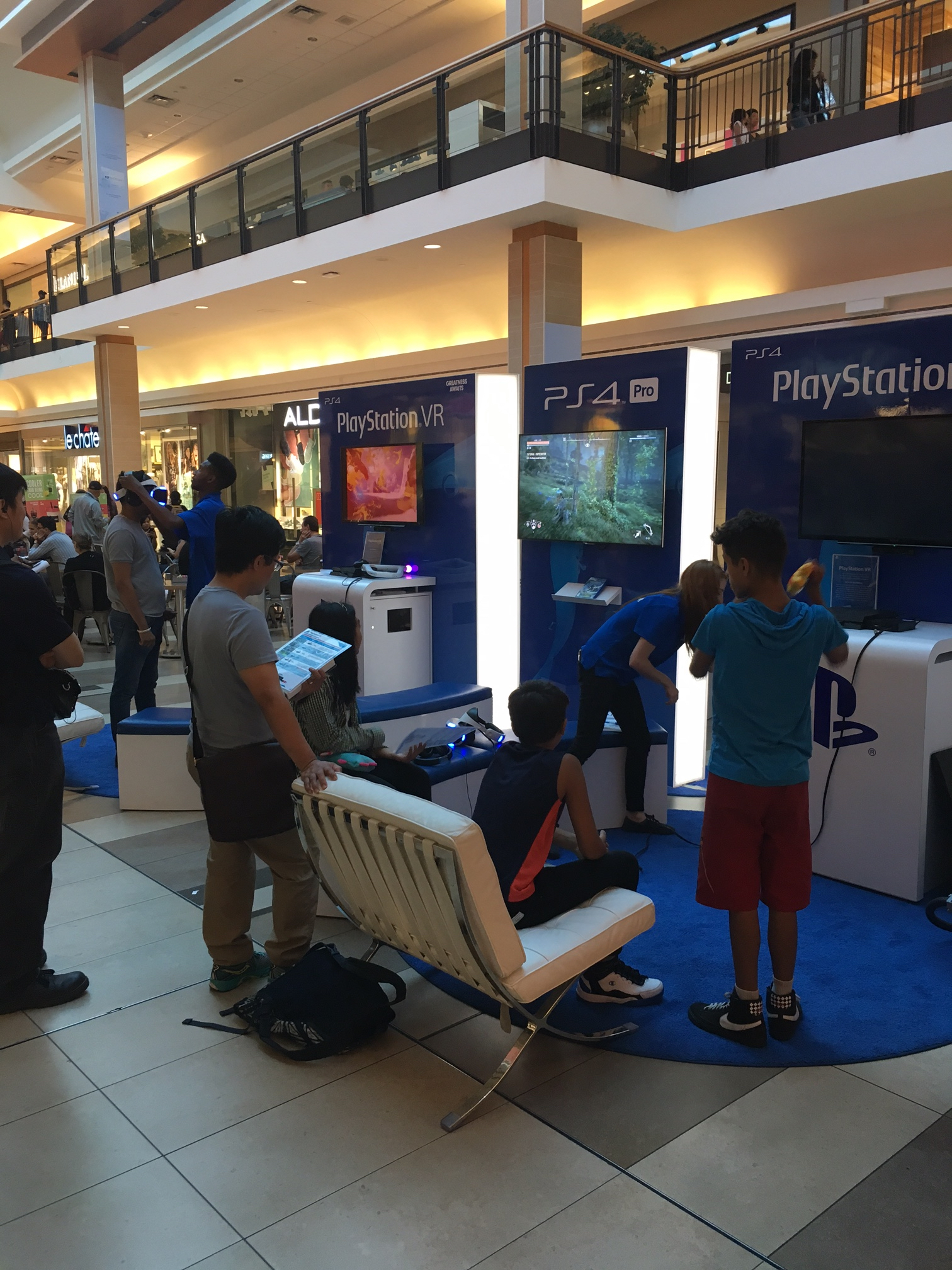
Prior research has argued that marketing strategies for the retail sector have changed direction from “push” to “pull”, and suggested that consumers need to take part in communication and advertising.3 Pop-ups can benefit from such “pull” marketing strategy by allowing consumers to have a different shopping experience in their shops. The idea is to put the consumers in the driver’s seat and let them touch the products, ask questions and enjoy the brand experience. Generally speaking, the pop-up environment should be experiential and highly authentic. Compared to typical retail shops that are more generic, pop-ups should be more unique, more fun and offer something extra.
1.1.3 Selling Feelings Towards Your Products
Pop-ups are not always meant to facilitate quick sales transaction. They can be used by companies to reinforce brand images, revitalize matured brands, or fix damaged brands. With this in mind, pop-up shops can be set up creatively as a fun, exciting and memorable place to capture foot traffic. For example, SC Johnson promoted its Glade fragrance products in New York City by creating a pop-up boutique whose aim was to “sell feelings”. The Glade Boutique featured a multi-sensory, immersive and interactive experience for shoppers. To enable visitors to further explore the brand, they were invited to experience the “Scent Lab” which featured a candle wall housing 1,500 back-lit scented candles4. SC Johnson encouraged their visitors to share their experiences via social media using the hashtag #FeelGlade. Furthermore, a 60-second behind-the-scenes video was made available on Glade’s YouTube channel.4
1.1.4 Making Your Product Available for a Short Period
Pop-ups that create a sense of urgency usually attract consumers’ attention and get them to pay a visit. In general, a short lifespan pop-up shop can generate foot traffic and attract customers easier than long-term ones from the viral marketing point of view. A good example can be seen from iZettle’s “The 12 Hour Store” in Central London, UK. This mobile payment solution vendor created a pop-up shop that lasted for only six days. Through a marketing competition, iZettle found six local small businesses and empowered each of them to trade out of this shop from 9:00 a.m. to 9:00 p.m. for only a day.5 To create a sense of urgency, iZettle put up street signs that said: “Grand opening today, grand closing tonight.”6
One of these six businesses was Iam Vibes. This brand achieved record-breaking sales after participating in “The 12 Hour Store”. Tom Hardless, founder of Iam Vibes, said, “Taking part in iZettle’s 12 hour store was a dream come true. The 12 hour store did not just give me a physical space to trade from; it gave me a huge morale boost.”7
1.1.5 Creating one-of-a-kind Pop-up Shop to Help Others
Traditionally, pop-ups are commonly used by major brands to attract customers with the ultimate goals of increasing sales. However, non-profit organizations are now taking advantage of the pop-up shop concept to practice the art of philanthropy. For example, The Haven Night Shelter for the homeless in Cape Town, South Africa, set up a temporary “Street Store” to let citizens donate clothings and winter accessories.8 The homeless people can in turn take the time to choose what they want in a location where they feel comfortable and familiar with — the street.
Similarly, there are social entrepreneurs who set up pop-up shops to let people buy products that get distributed directly to the poor in the city. An example is the pop-up shop “Crack + Cider” in London, UK that is organized by Scarlett Montanaro and Charlotte Cramer.9 “We decided that we just wanted to create a really simple, totally transparent model for charitable giving,” says Cramer. Their venture seem to be successful with expansion to Bournemouth and also San Francisco. These one-of-a-kind pop-up shops that help others often generate attention of the media and people like to spread the word over social media.
Did you know that?
- The first Street Store is born in Cape Town, South Africa in January 2014. Since then, more than 500 Street Stores have popped up in 200+ cities around the world.8
- Watch a video clip about the Street Store on YouTube.
1.2 Promotional Tactics for Pop-up Shops
1.2.1 Listing in Online Pop-up Directory
Without a permanent location, pop-up shops may be difficult to find. Some pop-up shops receive little foot traffic even though they are selling great goods. In addition to handing out flyers on the streets or advertising in local newspaper, pop-ups can consider listing their businesses in some pop-up specific online directories. For example, there are over 35,000 separate listings in the PopUp Republic directory, covering pop-ups across the United States.10
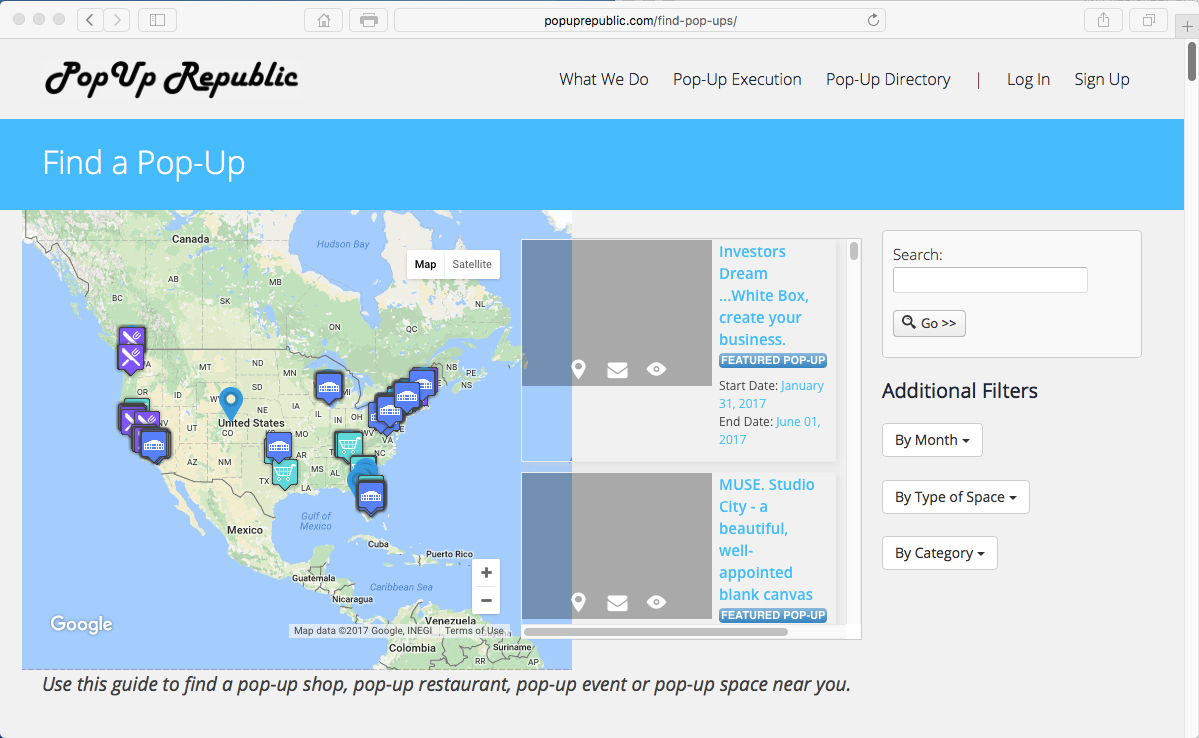
In Canada, there are also online directories that help people locate food trucks and other types of pop-ups. The key to success is to have a detailed, comprehensive listing that entices people to check it out.
Table 11.1 An example of a comprehensive food truck listing
| Items to include in a pop-up listing | |
| Name of business |
ABC Delicious Fast Food Truck |
| Description of business |
John was onto something special when he decided to quit his banking job to bring comfort food to the streets of Toronto. The delicious cuisine from ABC Delicious will surely KO your cravings. The gourmet Stuffed Wings are the stuff of legend, with crazy savory options. |
| Start Date | December 1, 2017 |
| End Date | December 10, 2017 |
| Hours of Operation |
11:30 a.m. to 6:00 p.m. |
| Location | In front of North York Centre on Yonge Street |
| Address | 5150 Yonge Street, North York, Ontario, M2N 6L6 |
| Contact Information |
John Smith, (416) 123-4567 |
| Website address |
http://www.abcdeliciousfastfood.ca |
| Social media accounts | Facebook.com/abcdeliciousfastfood |
Pop-ups can upload photos, videos and even user reviews to make their directory listing more attractive. It is also wise to include GPS coordinates and map information to help visitors locate the pop-up operation.
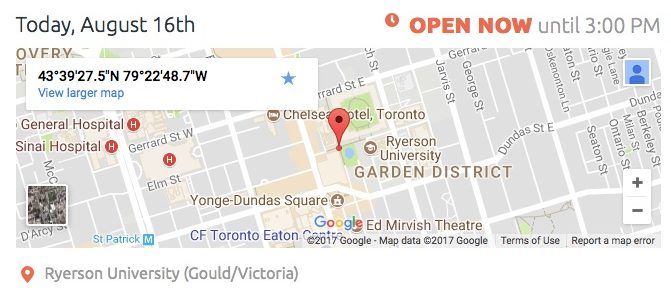
Figure 11.4 GPS and map information about a food truck11
Example
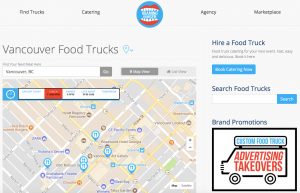
Roaming Hunger is an online portal and mobile app where food trucks can advertise their businesses. Visitors can search its online database to locate food trucks in North America. This site has gained popularity since it launched in 2009.
- Learn about how Roaming Hunger helps struggling food truck operators in this Los Angeles Times article.
- Watch an interview with Roaming Hunger’s founder on YouTube.
Figure 11.5 Map showing location of food trucks in Vancouver12
1.2.2 Reaching the Mass Market Through Traditional Media
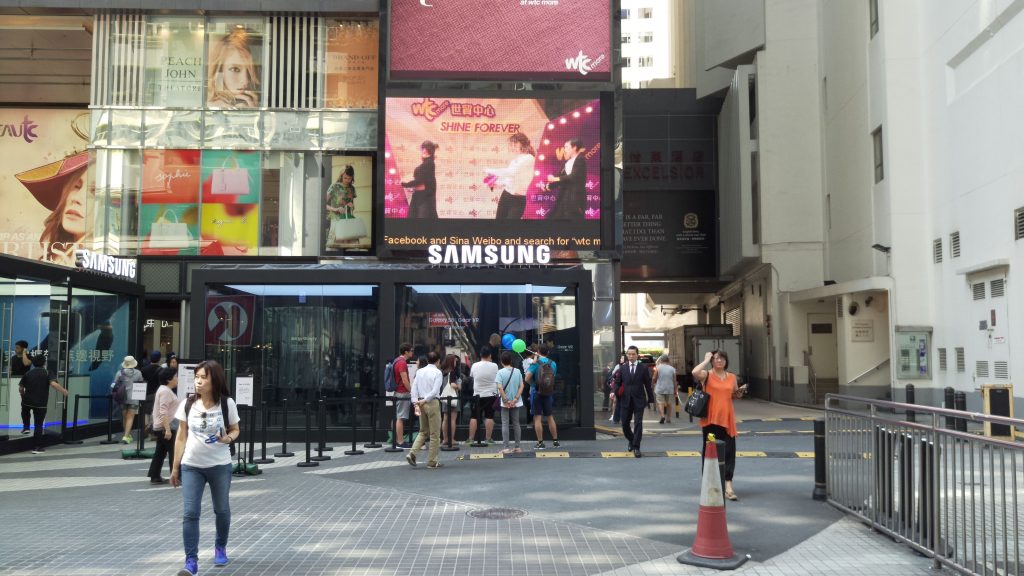
Although the impact of traditional advertising media such as newspaper, radio and TV has been drastically reduced in recent years, they are still useful as advertising tools. For example, when Samsung launched its Galaxy S8 series smartphone worldwide, it made use of traditional media to promote its pop-up experience centre in town.
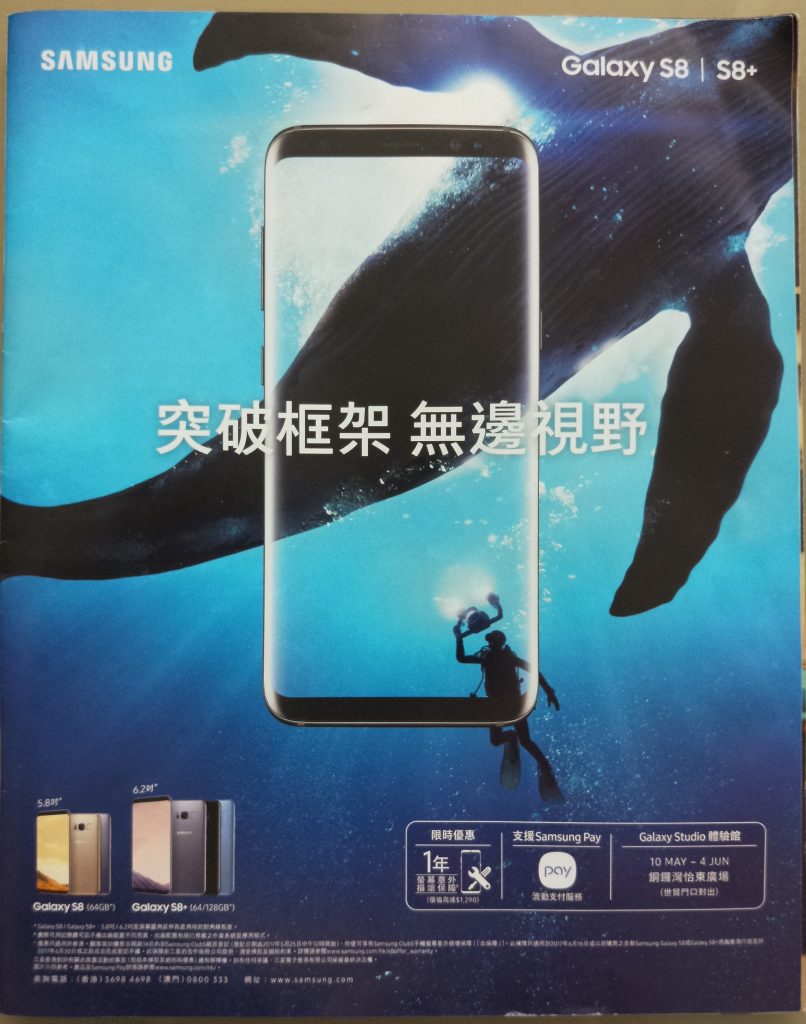
1.2.3 Taking advantage of the “Fear of Missing Out” (FoMO) Phenomenon
Pop-ups are often once-in-a-lifetime opportunities; they come and go quickly. If consumers missed these pop-up shops, they probably wouldn’t be able to experience them again easily. It is not uncommon to see consumers flocking to the pop-up shops once they learn about their existence. For consumers, to be “in the know” can be important in their social circles. This is particularly true when social media platforms facilitate rapid information sharing among friends and colleagues.13 Some people have a desire to stay continually connected with what others are doing, and are afraid of missing out on the latest trends. Pop-up shops can target those people who demonstrate this “Fear of Missing Out” (FoMO) phenomenon.
Did You Know?
- A 2013 study suggested that nearly three-quarters of young adults reported they experienced the FoMO phenomenon.14
-
FoMO was associated with lower need satisfaction, mood and life satisfaction.14
-
FoMO was robustly linked to higher levels of social media engagement.14
Example
In 2011, a group of volunteers in Helsinki, Finland created Restaurant Day, a food carnival that takes places four times a year (February, May, August and November). Restaurant Day enables individuals to realize their dream to run a one-day pop-up restaurant in their own location15 and has since expanded globally.
1.3 Pricing Tactics for Pop-up Shops
Pop-ups can use pricing as a way of attracting and communicating an offer to a potential shopper. In today’s retail environment, pricing is a competitive tool that retailers can use to better position their products or services.
1.3.1 Pricing Objectives
The first step in price development is to understand one’s pricing objective. A pop-up shop can be categorized as “profit oriented”, “sales oriented”, or “Status Quo oriented”. If the objective is profits maximization, pop-ups should have a clear picture about their cost structure and the price premium that they can charge. On the other hand, if the focus is on dollar or unit growth, they should run promotions and also price their products or service competitively to gain market share.
Pop-up shops that have operational constraints, such as limited production capacity or labour supply, may want to maintain their status quo. They may want to price their products or services to simply meet the competition to maintain their current production or service levels.
1.3.2 Price Level Policies
Once the pricing objective is determined, pop-ups can set their price level policies. Shops that sell unique products or services can consider the use of “Skimming pricing”, in which the initial price point is set very high before having gradual price reduction later. Consumers who are fear of missing out are typically willing to pay a premium to obtain the most trendy products or services.
If the pop-up shops are trying to get as many people as possible to experience their brands, they can make use of “Penetration pricing” in which the price is set artificially low during the product introductory phase. The low price point can also be useful when the products or services are relatively unknown to the consumers, as it offsets the perceived risks in such kind of purchase.
1.3.3 Full-line Pricing and Prestige Pricing
“Full-line pricing” refers to the presentation of a set of price points of a product family. When shoppers do not have a strong preference of a particular product, they would typically pick the middle one among the “Good”, “Better”, and “Best” product selection. The use of Full-line pricing can help pop-ups better manage their inventory levels.
Some pop-up are operated by luxury brands. They may use “Prestige pricing” in which the price remains high all the times in order to maintain the brand’s premium market positioning.16
1.3.4 Offering Free Merchandise in Exchange for Social Currency
Prior research of social media as currency has demonstrated significant, positive correlations between posts and increased e-commerce.17 Considering that much of the Millennial generation is rich in social currency, pop-up shops can consider offering patrons free merchandise in exchange for their tweets, or postings on Facebook, Instagram and Pinterest.
In the UK, Marc Jacobs was trying to promote its Daisy Dream fragrance. As part of its multi-faceted marketing campaign, Marc Jacobs set up a 3-day tweet shop in London. Shoppers could purchase goods only with social currency by using the hashtag #MJDaisyChain. The value of goods that could be exchanged for social currency went up as shoppers put more effort into their tweets, such as adding images or video clips. According to Marc Jacobs, their launch of tweet shop was preceded by considerable amount of press coverage and hype prior to the shop opening.19
Examples
- In 2012, Kellogg’s Special K established the world’s first “tweet shop” as part of its social media campaign to push its entry into the crisps market.20
- Watch this video about the Marc Jacobs tweet shop in London
1.3.5 Turning Shoppers’ Social Currency into Discounts
American fashion brand OnePiece opened a pop-up in New York City where shoppers got discounts with their social currency. It created the “PieceKeepers” OnePiece ambassador system in which customers connected their various social media accounts to establish their degree of influence. For every 500 followers, shoppers can earn $1 towards their purchase, up to $20. Shoppers can check the worth of their social connection by using an online calculator.21 To collect their social shopping discount, shoppers upload and share an image in the shop using the #socialcurrency hashtag.22
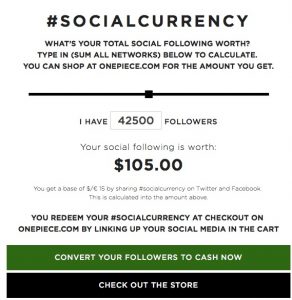
1.3.6 Trading Friends for Free Merchandise
In 2015, software developer ooVoo set up a pop-up shop called “ooVootique” for 13 days in Austin, Texas to promote its social media app23. In this pop-up shop, ooVoo only accepted payment in the form of friends in a visitor’s ooVoo roster. For example, a micro scooter bike would cost the visitor “2000 friends”. By encouraging influencers to trade their ooVoo friends for merchandise, ooVoo hoped that people would spread the word and get others to join the ooVoo social network.
1.3.7 Accepting Kindness as Payment
Setting up a “Tweet Shop” to let people exchange free merchandise with tweets can be a good tactic as part of a brand’s social media campaign. If organized properly, this can be used by a brand to promote corporate social responsibility. For example, Unilever has a skincare brand called “Simple”. To differentiate itself from the crowd, Unilever’s set up the “#KindIsSimple” pop-up shop in London, UK but it was not selling or promoting any specific products there. Instead, visitors to the pop-up shop were asked to reflect upon themselves, tweet about their acts of kindness, and also suggest ways to make the society better.24
To increase people’s dwell time in this pop-up shop, visitors were encouraged to write a note for their friends on the Kind Words Wall, relax at the Cup of Kindness Water Bar, or check out the Kindness Tree where thoughtful acts were hanging. The pop-up shop also ran expert panel sessions with skin experts, nutritionists and make-up artists. When asked about the benefit of this pop-up shop, Philippa Bealey, brand manager for Simple at Unilever UK said, “Running this campaign via Twitter and Instagram provides an excellent platform for us to reach our target audience and drive the conversation in a space that is relevant to them.”25
1.4 Place Tactics for Pop-up Shops
1.4.1 Collaborative Pop-ups: Selling Together with Other Pop-up Vendors
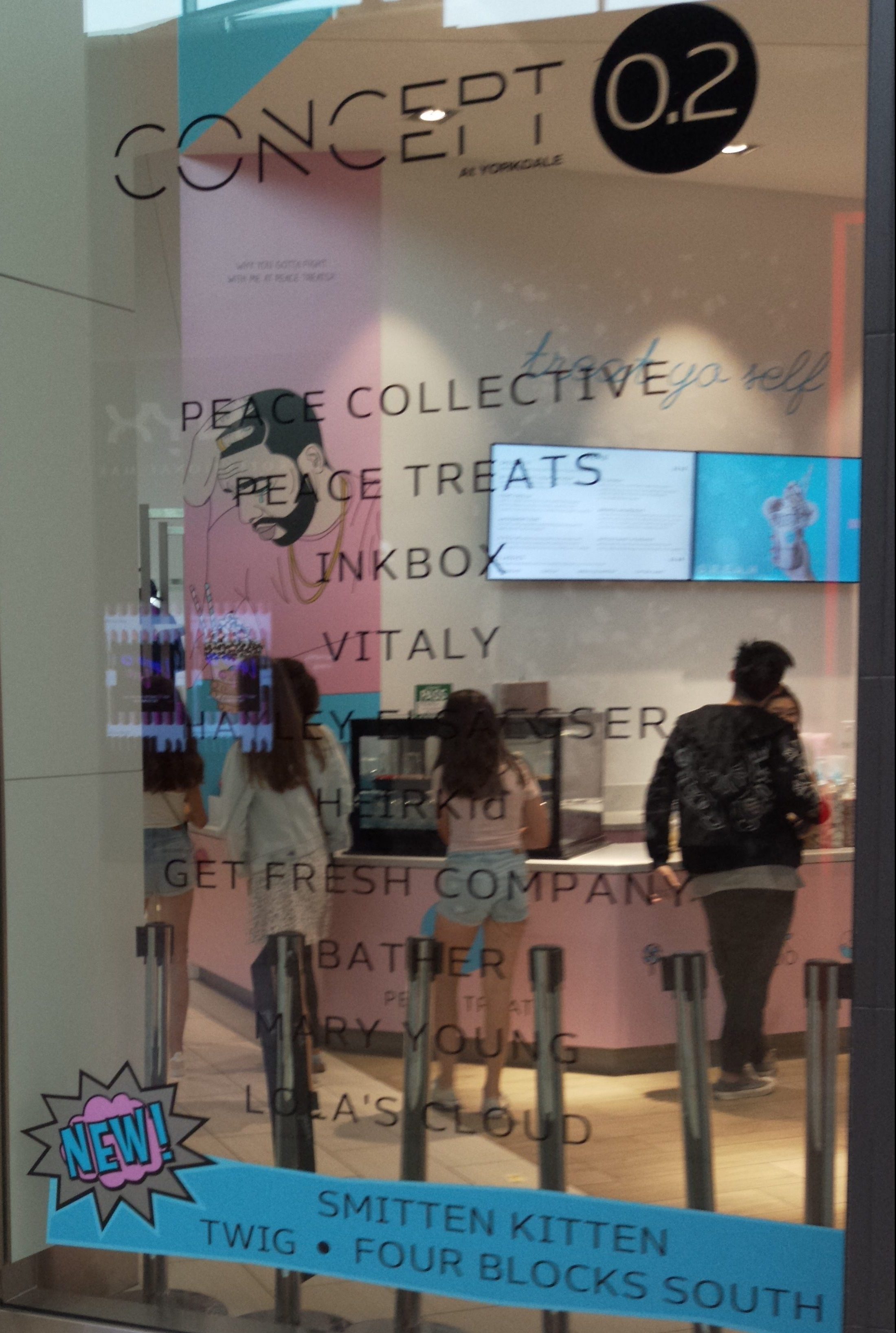
The CONCEPT pop-up retail space in Yorkdale Shopping Centre in Toronto was a temporary home to over ten different smaller brands. By presenting shoppers with several brands under one roof, it was able to attract curious consumers to spend more time in the shop to explore various product and service offerings.
This tactic is also used commonly in the food truck business. By collaborating with other food truck operators to do business together, the vendors can usually draw more people to the area as shoppers like to compare products before making a purchase.
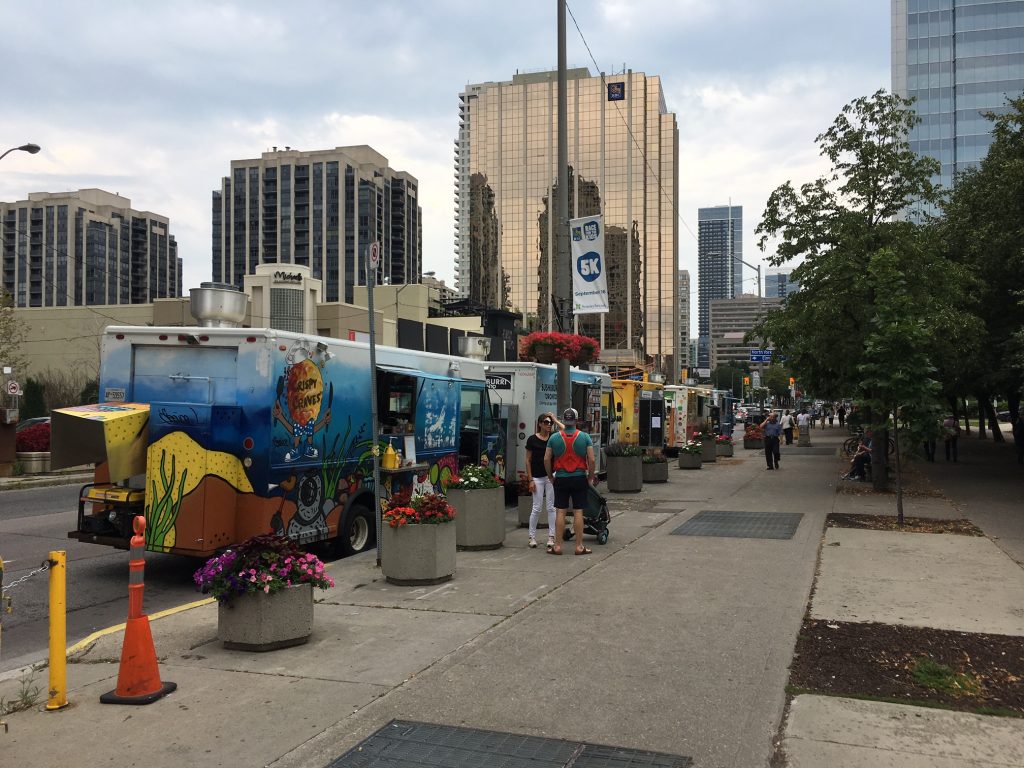
1.4.2 Setting Up in an Iconic Building
For big brands that have deep pockets, they can consider building a unique pop-up shop specifically to showcase their brands. The iconic design of the pop-up shop would not only draw the media’s attention, but also attract people to take photos and share them over social media. During the 2015 NBA All-Star weekend festivities in New York, Nike set up a giant pop-up shop called “the Zoom City SNKRS Station” that looked like a shoebox.26
Another example is the online bank Tangerine, which placed a pop-up showroom inside an orange cargo container in the parking lot of the Centrepoint Shopping Mall in Toronto. The bank was trying to make their online banking service “tangible” and help residents better understand their service offerings.
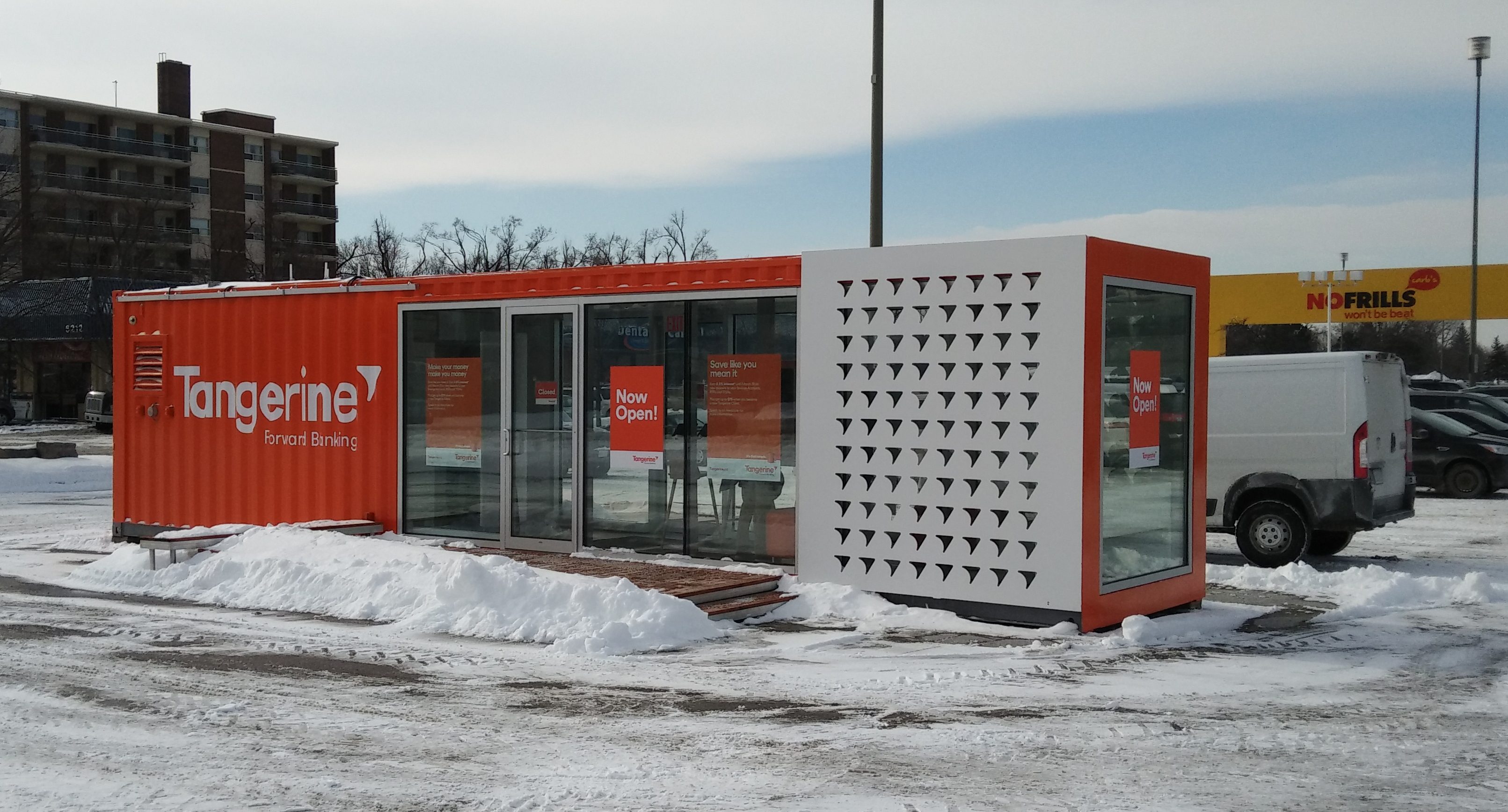
1.4.3 Piggybacking with a Reputable Bricks-and-Mortar Retailer
Setting up a standalone pop-up shop is costly and the ideal location may not be available. A solution is to piggyback on the success of a reputable bricks-and-mortar retailer. For example, Nutella chose to set up a pop-up shop inside Longo’s supermarket in downtown Toronto in the form of a tasty Nutella Creperie. Visitors were encouraged to share their experience using the #NutellaMoments hashtag on social media, in order to earn a chance to win a personalized prize pack filled with pastries and donuts.27,28
1.4.4 Collaborating with a Shopping Mall
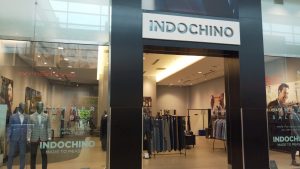
Shopping malls are motivated to experiment with niche retail concepts to generate foot traffic. They are interested in bringing all kinds of pop-up shops to their site to create a more exciting mix of tenants.
An increasing number of shopping malls and upscale brands are embracing the pop-up shop format. For example, The Shops at Columbus Circle in New York created a permanent retail pop-up installation called a “Luxury Merchandising Unit (LMU).29 It has housed upscale brands such as Hermès, La Maison du Chocolat, Moleskine, Sugarfina and Tesla.30
Shopping malls have relatively deep pockets to fund various promotional activities. Pop-up shops should leverage the marketing support provided by the shopping malls, whether it’s an advertisement in the shopping guide, an interview article on their website or a tweet that goes out to thousands of their followers.
1.5 Customer Service Considerations for Pop-up Shops
1.5.1 Hiring Approachable and Friendly Staff Members
The simplicity, friendliness and relatively laid-back style of the pop-up shop should be represented by the staff hired to interact with the customers. Consumers who are new to the brand, especially the upscale ones, may find the pop-up environment a great starting point to learn about the brand. As a result, these pop-up shops should be designed in such a way that is pleasant, amusing, agreeable and fun.31 Most importantly, pop-up shops need to hire staff members who can demonstrate these characteristics, and who feel comfortable working in a pop-up environment.
1.5.2 Ensuring Staff’s Compensation Reflects the Pop-Up Business Model
The pop-up environment should be welcoming, one that encourages consumers to have face-to-face dialogue with the brand representatives. Therefore, pop-up retailers should recruit knowledgeable brand representatives who can also assist in creating and delivering a distinctive customer experience at their pop-up shops.
Prior research has also argued that consumers shop together as part of their social activities. These consumers visit the pop-up shops to show their devotion and support to the brand, and not necessarily with the intent of making a purchase.32 With this understanding, brands should pay attention to how they compensate their staff when generating sales is not always the business objective at these pop-up locations.
2. Social Media Marketing: A Key Factor For Pop-Up Retail Success
2.1 Marketing Opportunities Presented by Social Media
It is not uncommon to see retailers beefing up their social media marketing initiatives as they try to get ahead in their omni-channel retailing journey. There are many activities that pop-ups can consider. As the first step, they can set up Facebook accounts to showcase new products to get their fans and customers excited. Pop-ups can also tweet about limited time offers, and share photos and videos over Pinterest, and Instagram. To maximize a brand’s social media engagement, some pop-ups go out of their way to build specific stations or kiosks inside the shop that revolve around Facebook, Twitter and Instagram activities.
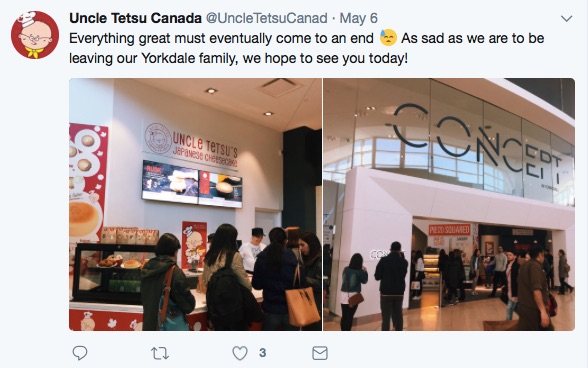
The power of social media comes when Key Opinion Leaders (KOLs) “retweet” or “like” the content posted by the pop-ups. These KOLs may have hundreds or thousands of followers, so they can serve as pop-up shops’ brand ambassadors to help them get the word out quickly.
Social media can serve not only as a pre-sales communication channel to promote new products or services, but also as an after-sales support channel to collect customer feedback and resolve issues. Nowadays, consumers are keen on participating in open dialogue because it allows them to feel important and like they have a voice.33 Pop-ups can make proper use of social media platforms for other business purposes as well. For example, they can announce job postings over LinkedIn, and learn about their competitors’ latest development using Tweetdeck, Twitter search, or Google Alerts.
2.2 Live Video Streaming
The rapid growth of live video streaming on Twitch, Periscope, and Facebook Live provides an excellent promotional opportunity for pop-ups. These platforms are great for pop-ups to stay relevant and ignite real-time conversations with people about their shops.34
There are many great video streaming ideas that pop-up shops can consider. For example, they can put together a video as a teaser for their upcoming store opening and then live stream the opening event and interview customers in attendance. They can also broadcast during product launches and arrange product specialists to go over the new product features. Pop-up shops can broadcast behind-the-scenes footage to create buzz around the brand.
An important consideration is that these live streamed videos can be created by other people who may be interested in the pop-ups. A good example of this is the Periscope video broadcasted by Ok Taec-yeon, a famous Korean singer from the 2PM group, during his visit to the OKCAT pop-up shop in Seoul, Korea. His video was subsequently uploaded to YouTube and was viewed over 9000 times.35
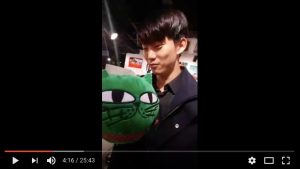
2.3 Selecting the Right Social Media Platform
There are many social media platforms in the market. In North America, one can establish a presence on major sites such as Facebook, Twitter, Instagram, Pinterest and YouTube. When choosing social media platforms, it is important for pop-ups to understand the demographic composition of these sites, so that the right kind of shoppers can be targeted.36
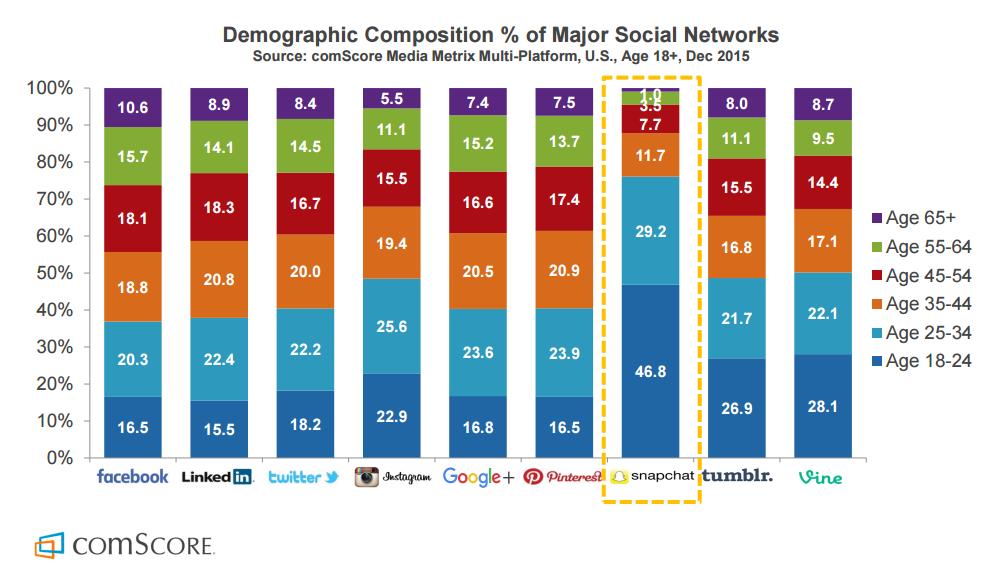
The social media world has evolved rapidly. The best platform for pop-ups a few years ago may no longer be relevant nowadays. For example, MySpace and Google+ were once social media leaders in the mass market, but they had to shift their focus to serve users in their niche markets since overtaken by Facebook and others.37
Note that not all of the mentioned social media sites are available globally, as foreign governments block some due to political censorship. For example, popular social media platforms such as Facebook, Twitter, YouTube and Pinterest are blocked in China due to censorship. Instead, Chinese Internet users utilize alternative services such as those from Renren, Weibo, Youku and Baidu.38
Did You Know?
- Out of 7.48 billion people on this planet, there are 3.77 billion Internet users and 2.79 billion active social media users.39
- Some retailers display a Service Level Objective (SLO) on their social media sites. For example, Royal Dutch Airlines (KLM) shows a “We expect to reply within X minutes” on its Twitter account and this number changes every 5 minutes.40
- The top 5 social network sites, as measured by active users, are Facebook (1.8 billion users), WhatsApp (1.3 billion users), Facebook Messenger (1.2 billion users), QQ (877 million users), and WeChat (846 million users).41
- In Canada, two out of the top eight retail brands have over 50% of their audiences visiting exclusively from a mobile device.42
- 2.4 Developing Effective Social Media Messages
Setting up a social media account is easy but creating effective messages that resonate with consumers can be a challenging task. There are many types of content that pop-ups can share over social media.
Table 11.2 Types of content that can be posted on social media
| Types of Content | Description |
| Insight | Pop-up retailers can share their views towards industry trends or specific competitive offerings. They can also invite Influencers or Key Opinion Leaders (KOL) to share their insights as well. |
| Expertise | Pop-up retailers can be experts in their industries; they can answer questions about a particular product or service as raised by community members. |
| Images | Pop-up retailers can share photos about their new product or service offerings. They can also post behind-the-scenes images to get people excited about their operation. |
| Data | Pop-up retailers can share interesting statistics about their industry, brand or product. |
| FAQs | Pop-up retailers can post frequently asked questions to help customers learn about the brand, use the products or enjoy the services. |
To maximize audience reach, pop-up retailers can consider adding hashtags in their social media postings. When Google set up its “Made By Google” pop-up store in New York City43,44, certain hashtags such as “#Google”, “#popupstore” and “#NYC” were used extensively in their social media postings. The benefit for Google is that it can easily find all online conversations that are related to this pop-up shop by searching these hashtags on Twitter and other social media platforms.
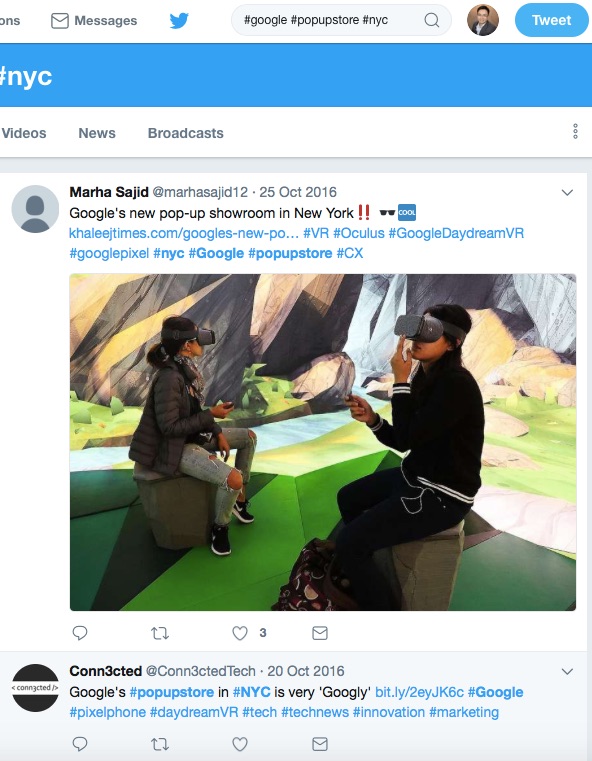
Pop-up retailers should understand that social media is not a press release. It is not merely about reaching a bigger network of people on the Internet. Instead, it is about engaging customers actively and pulling them into a conversation. For pop-ups that are having a joint promotion with other brands, they should consider distributing their pre-crafted advertising message across their strategic partners’ social media channels as well, and not just their own.
Tips for Microblogging
Microblogging, or sharing small pieces of content such as tweets or status updates, can be a cost-effective way for pop-up shops to engage their customers.
-
Regular tweeting is key to brand success. 74% of brands tweeted at least three times per day (including Retweets and @replies).45
-
Tweeting out links is becoming the social standard. The number of links tweeted by brands increased 72% from Q4 2013 to Q4 2014.46
-
Brands are interacting more with individual users, especially in the restaurant industry. @Replies made up 68% of all brand tweets.47
-
The opportunity to connect with consumers is ripe on Twitter. Engagement with brand tweets was up 105% year over year.48
-
Visual content works. Photos inspired 57% of all engagement with brand tweets—a 6% increase from just the previous quarter.49
3. Developing an Effective Multi-Faceted Marketing Campaign
3.1 Campaign Management
Earlier in this chapter, you explored the Marketing Mix (4Ps) and learned about the growing importance of social media marketing for pop-ups. Now, let us see how an effective multi-faceted marketing campaign should be developed. Just like any business project, a marketing campaign must be well designed, implemented and evaluated. Pop-up operators need to consider the following aspects when planning their marketing campaigns:
- Goals: What are the goals of this marketing campaign?
- Audience: Who needs to respond? What response?
- Motivators: What motivates this audience?
- Messages and messengers: What must you say to get the desired response? And who must say it?
- Media and moments: Through what media and when should you engage your audience?
- Execution: What specifically will you do and when?
- Metrics: How will you measure progress towards success?
3.1.1 Goals
The first step in campaign management is to understand the goals of such a marketing campaign. Is the campaign designed to stimulate sales, generate brand awareness or both? Are there relevant organizational, departmental and/or communications goals that must be achieved through the delivery of this marketing campaign? No matter what the goals are, they must be time-specific, easy to understand and measurable.
3.1.2 Target Audience, Motivators and Key Messages
The next step in campaign management is to identify the target audience. Sometimes, pop-up retailers may have more than one group whom they want to target. The needs of these primary and secondary target audience may be different. Before developing the key messages, retailers need to first understand what motivates this audience to consider the brand. The advertising contents developed should set the pop-up shop apart from the competition, sound authentic, have a current angle and probably answer a target audience’s dream, desire, problem or fear.
Pop-up shops also need to understand what type of messengers their target audience trust, the type of media they consume the most, and the moments when they will be most receptive to such messages. All of these can be summarized in a strategy statement which encapsulate the retailer’s overall approach to messaging, messengers, media and moments.
3.1.4 Tactics and Metrics in a Campaign Calendar
A campaign calendar should be developed to show what tactics and metrics will be used at a particular time. It is not uncommon to see pop-up shops having different business objectives throughout the campaign. For example, a shop may want to maximize its brand awareness in week one but focus on sales in week two. In this case, the metrics will be foot traffic and sales revenue, respectively. No matter whether the caledar is displayed in weekly, monthly or even quarterly format, it is all about understanding the business goals and how the proposed online and offline marketing activities can help achieve these goals.
3.1.5 Budget
Successful campaigns are always backed by a reasonable budget. When working out the numbers, some marketers make the mistake of ignoring certain cost elements, such as travel (meals, flights, car rental, hotels) and training (internal and external). Try to think of all incremental costs that you may need to shoulder in addition to the Integrated Marketing Communications expenses when running the marketing campaign for your pop-up shop.
Budget should never be set in stone, as market reaction to your campaign can be difficult to predict. For example, say your marketing campaign is to give out free toys for brand promotion purposes. What if it becomes a great success and all the toys are gone only two days into your week-long marketing campaign? You need the extra budget to source additional toys and have them shipped to your pop-up shop in an expedited manner, to avoid disappointed potential customers.
Key Takeaways
In this chapter, you learned:
- about the importance of social media as an advertising platform for pop-up retailers to get the word out in viral marketing
- that pop-up retailers can get consumers’ attention by running a short lifespan pop-up shop, locating in a unique design infrastructure and providing an unforgettable experience at the pop-up shop
- how pop-up retailers can partner with other stakeholders such as key opinion leaders, shopping malls and other pop-up retailers to create a win-win situation
- what social currency is and how pop-ups can use it creatively for promotional purposes
Key Terms:
- Key Opinion Leader
- Hashtag
- Crossover Branding
- Social Currency
- Tweet Shop
Mini Case Study
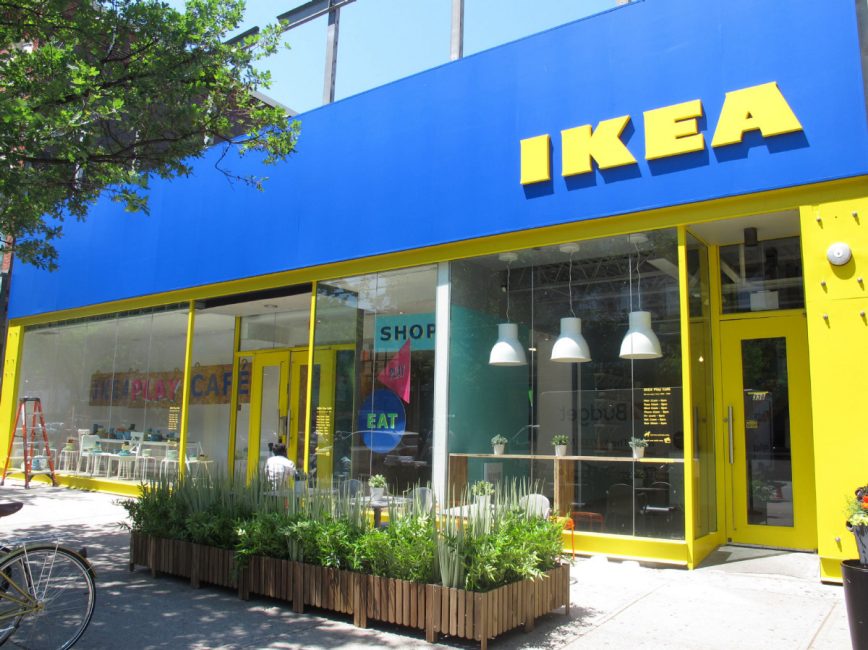
The Swedish furniture retailer, IKEA, has been active in setting up pop-up shops to promote its brand in recent years. In May 2016, it set up the #StartFooding pop-up shop in downtown Toronto to provide the local residents with a unique culinary experience. IKEA offered 50 food-related products for purchase in the pop-up, ranging from recipe books, green displays and inexpensive Swedish dishes.50 After the initial success, IKEA established another pop-up in the same neighbourhood the next year. This time, the #IKEAplaycafe combined shopping, playing and eating in the almost 8,000 square foot pop-up space. It offered IKEA’s signature frozen yogurt, Swedish meatballs, chicken balls and veggie balls. Visitors could be creative and try different sauces and waffles, fried onions, chips, pickles or biscuits. There are also games that visitors could play while they shopped. IKEA also selected 50 houseware items, from pillows and artificial plants to teacups and cutting boards, to be sold in this pop-up shop.51
Consider the following questions:
- IKEA is a furniture company, but its two IKEA pop-up shops in Toronto are food-related. The products presented in the pop-up shop are geared towards cooking, eating, entertaining and serving. Let’s assume that IKEA would like to establish a pop-up shop next year in the same neighbourhood, should it continue to promote food products, switch to promote furniture or do a combination of both?
- How can IKEA leverage the concept of social currency to promote this pop-up shop?
- Should IKEA set up similar pop-up shops in other parts of the city? If so, how many, how often and for how long? Currently, IKEA’s pop-up shop is located in downtown Toronto and is only available over the summer every year for about 12 days each time.
References
- Eva’s Original Chimneys (2017, May 3, 2017) at 8:40pm UTC. (2017, May 3). Limited-Edition@uncletetsucanada CHIMNEY CONE! [Instagram photo]. Retrieved from https://www.instagram.com/p/BTpNnGCl2vd/?taken-by=ogchimneys
- Baras, J. (2016). Popup republic: how to start your own successful pop-up space, shop, or restaurant. Hoboken, NJ: John Wiley & Sons, Inc.
- Balasubramanian, S. K. (1994). Beyond advertising and publicity: Hybrid messages and public policy issues. Journal of Advertising, 23 (4), 29-46.
- S.C. Johnson. (2014). Visit the first-ever pop-pp Glade® boutique and give the “Gift of Feelings.” This Season. [Press Release]. Retrieved from http://www.scjohnson.com/en/press-room/press-releases/11-18-2014/Visit-the-First-Ever-Pop-Up-Glade-Boutique-and-Give-the-Gift-of-Feelings-This-Season.aspx
- Retail Gazette (2014, December 8) IZettle opens up heart of London to six small businesses with 12 Hour Store campaign.
- McQuarrie, L. (2015, January 7). iZettle’s temporary store hosts businesses for just 12 hours. Trend Hunter.
- Foster, L. (2014, November 19). 12 hours of fame – the iZettle stunt that made small businesses shine. Flavour Magazine.
- Uys, E. (2016, August 24). The Street Store: Pop-up charity for the homeless. Design Indaba.
- Peters, A. (2016, November 11). At This Pop-Up Shop, You’re Buying Clothes For The Homeless—Not Yourself. Fast Company.
- PopUpRepublic. (2016). What We Do.
- Toronto Food Trucks. (2017). Little Havana Café.
- Roaming Hunger. (2017). Vancouver Food Trucks.
- Elhai, J. D., Levine, J. C., Dvorak, R. D., & Hall, B. J. (2016). Fear of missing out, need for touch, anxiety and depression are related to problematic smartphone use. Computers in Human Behavior, 63, 509-516.
- Przybylski, A. K., Murayama, K., Dehaan, C. R., & Gladwell, V. (2013). Motivational, emotional, and behavioral correlates of fear of missing out. Computers in Human Behavior, 29(4), 1841-1848.
- RestaurantDay. (2017, July 14). Raflavaunu serving customers in Turku, Finland, on a sunny Restaurant Day in May
- Crane et al. (2017) Marketing, Chapter 13 Pricing Products and Services. Toronto, ON: McGraw Hill Ryerson, Toronto
- Randall, K. (2010, July 20). How to measure brand value: Likes, followers, influencers, views? No, social currency. Fast Company.
- Austin, B. (2016, August 30). What can social currency buy you? Vivaldi Group.
- Abrell, A. (2014, August 11). Marc Jacobs launches digital-themed fragrance pop-ups in London. Fashion&Mash.
- Chapman, M. (2012, September 25). Special K launches Tweet Shop campaign for new crisps range. Campaign.
- OnePiece. (n.d.). #socialcurrency.
- Sargent, F. (2014, November 10). C.R.E.A.M. (Clout Rules Everything Around Me): A SoHo Pop-Up Shop Lets Customers Pay with Their Social-Media Followers
- Posterscope (2015, May 21). The ooVooTique Lets Extroverts Exchange Friends for Products.
- McQuarrie, L. (2015, May 30). London’s Simple Skincare pop-up accepts kindness as payment. Trend Hunter.
- Deighton, K. (2015, May 20). Simple to accept kindness as currency at London pop-up. Campaign.
- Atomic. (2015) Nike Zoom City SNKRS Station.
- Mangione, K. (2015, May 4). Nutella craze spreads to Longo’s with Creperie. CTV News.
- Bayview News. (2015). Scenes from the Nutella Crêperie at Longo’s Leaside.
- Chamberlain, L. (2016, September 29). Why luxury labels are embracing pop-up shops. GeoMarketing.
- The Fashion Law. (2015, October 28). Hermès has opened another pop-up shop in New York.
- Lassus, C. D., & Freire, N. A. (2014). Access to the luxury brand myth in pop-up stores: A netnographic and semiotic analysis. Journal of Retailing and Consumer Services, 21(1), 61-68.
- Holmgren, A. & Bertilsson, J. (2015). Pop-up stores: The attraction of ephemeral experiences. (Masters Dissertation). Lunds Universitet, Lund, Sweden.
- Gonzalez, M. (2016). The pop-up paradigm: How brands build human connections in a digital age (2nd ed.). New South Wales, Australia: Lioncrest Publishing.
- Alton, L. (2016, September 16). 6 tips for successfully marketing your first pop-up shop. CIO Magazine.
- 2PM SNS Videos. (2016, December 17). 161217 Taecyeon’s Periscope #2 – Again, exploring OKCAT Pop-Up Store [Video file]. Retrieved from https://www.youtube.com/watch?v=C7olFMKUNI4&t=1217s
- Hutchinson, A. (2016, March 31). New comScore traffic report underlines the strength of facebook, rise of snapchat. Social Media Today.
- Bell, K. (2017, January 18). Google isn’t dead and these are the people still using it the most. Mashable.
- Pham, S. (2017, March 17). China adds Pinterest to list of banned sites. has been blocked in China. CNN Money.
- Kemp, S. (2017, January 24). Digital in 2017: Global overview. We Are Social.
- Royal Dutch Airlines.
- Chaffey, D. (2017, May 17). Global social media statistics summary 2017. Smart Insights.
- Wall, M. (2017, June 21). Trending now – The impact of mobile on the retail category in Canada. ComScore.
- Guynn, J. (2016, October 7). #MadeByGoogle Pixel shop to pop up in NYC. USA Today.
- Segan, S. (2016, October 20). Touring Google’s NYC pop-up store. PC Magazine.
- Hitz, L. (2015, February 10). 73% of Interbrand 100 brands have over 100K Twitter followers. Simply Measured.
- Simply Measured. (2014). Simply Measured Q4 2014 Twitter Benchmark Report.
- Shively, K. (2015). The State of Social Marketing 2015 Report. Simply Measured.
- Ennis, A. (2015, February 10). Brand engagement on Twitter rises 105 percent year over year. Simply Measured – Press Release.
- Avila, R. (2015, May 13). Drive engagement through visually appealing social media posts. All Global Ventures.
- Farha, L. (2016, September 12). What’s with the pop-up phenomena in Canada? Retail Insider.
- Lalani, A. (2017, June 15). Pop-up IKEA café coming to Queen St. W. Toronto Star.

